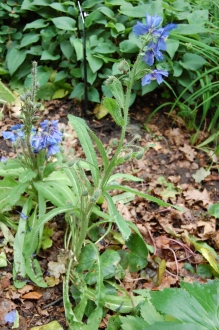Position: Dappled shade
Flowering period: Late spring to early summer
Soil: Moist, well drained
Eventual Height: 1m
Eventual Spread: 45cm
Hardiness: 6a, 6b, 7a, 7b, 8a, 8b, 9a
Family: Papaveraceae
Meconopsis horridula is a deciduous monocarpic (flowers then dies) plant. Its mid green leaves are lanceolate to elliptical with entire margins, up to 20cm long, 25mm broad and appear as a basal rosette. Its stems, leaves and pedicels have spines on their surface. Its blue terminal flowers have four petals and are up to 8cm across. Its fruit is an erect green spiny oblong to elliptic pod. Its roots are fleshy taproot.
Meconopsis horridula, commonly known as the Prickly Blue Poppy, is native to south eat Tibet and central and eastern Himalayas and west China. In its native habitat it grows on rocky ground and grassy slopes at an altitude of between 3,100m – 6,000m.
The etymological root of the binomial name Meconopsis is derived from the Greek meaning ‘Poppy like’. Horridula is derived from the Latin horridum meaning ‘ bristly’.
The landscape architect may find Meconopsis horridula useful as a part of a woodland understory planting scheme. This plant prefers a shelters location. Due to its monocarpic nature it will need to be replanted every couple of years, unless it successfully self seeds. Once established this plant is drought tolerant.
Ecologically, Meconopsis horridula is attractive to pollinating insects.
Meconopsis horridula prefers moist, humus rich, well-drained soils. It prefers a neutral to acid pH of soil.
Meconopsis horridula requires little maintenance.






The following monocarpic non-blue forms may be more readily obtainable, if not as plants, then by raising from seed. M. napaulensis (of hort.), M. paniculata, M. punicea, M. prattii (often known in gardens as M. horridula, which is not strictly correct), M. pseudointegrifolia, M. integrifolia (seemingly not at all commonly grown at present, although it was a number of years ago) and M. superba.